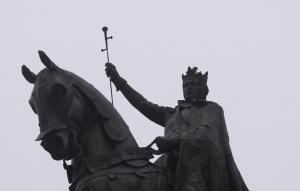
Since I last wrote on this subject, my post discussing neo-integralism got some pushback from those sympathetic to this particular strain of postliberal political theory. In particular, I was advised to read Andrew Willard Jones’s Before Church and State: A Study of Social Order in the Sacramental Kingdom of St. Louis IX. (Yes, that St. Louis.)
St. Louis’s kingdom, the argument runs, is the leading historical exemplar of the integralist vision—strong evidence that the modern distinction between “sacred” and “secular” rests on questionable premises, and that a successful society can be formed that doesn’t rely on contemporary liberal categories of “private” and “public” reasoning. If it’s fair to invoke the American Founding as “liberalism at its best” (at least, its aspirational best), it’s only fair to give the integralists their historical ground.
So I read the book.
The central theme of Jones’s study is “the business of the peace and the faith,” a concept which permeates many texts from Louis’s reign (1226–1270). In Jones’s telling, the phrase reflects a convergence of spiritual and temporal interests—more specifically, the interests of the Catholic Church and of St. Louis IX’s “most Christian kingdom”—that calls the modern sacred/secular dichotomy into question.
Under Louis, society was understood as a seamless fabric governed by the “two swords” of spiritual and temporal power (note: this is decidedly not Luther’s “two kingdoms” doctrine). The spiritual and temporal powers were not rivalrous, but complementary—such that, according to Jones, modern ideas of “Church and State” are simply inapplicable paradigms. Underpinning this fabric was a shared sacramental understanding of reality: the apprehension that the transcendent God is immanently present in, with, and under all of His creation. (Okay, I’m sneaking in a Lutheran phrase there. But it’s entirely apt.)
According to Jones, this understanding of God’s sustaining presence resulted in a radically different view of social relations. Contra Hobbes’s “war of all against all,” a sacramental understanding of reality posited an essential peace as the foundation of human affairs. Governance was not simply a matter of managing competing rival interests or monopolizing the use of violence, but of restoring a primordial peace when that peace was disrupted by heresy or unrest. The “default,” in other words, was harmony.
Before Church and State could’ve been a turgid journey, but it most assuredly is not. Jones makes difficult concepts accessible in an engagingly written volume that reads more smoothly than fully 90% of history books I’ve picked up. The book is positively packed with fascinating anecdotes and context that don’t show up in freshman-year Western civilization classes. For example, it certainly wasn’t obvious to me that St. Louis was a contemporary of St. Thomas Aquinas.
On that note, Jones’s critique of the sacred/secular binary owes much to the reading of Aquinas pioneered by John Milbank, Catherine Pickstock, Graham Ward, and others in the “Radical Orthodoxy” school. Now, I’m exceedingly sympathetic to the philosophical conclusions drawn by Milbank and company—who I’d credit with revitalizing the tradition of classical theism against the “theistic personalism” of Alvin Plantinga and others—but their work doesn’t feel quite as apposite here as Jones clearly believes it is.
A bit of background: the eschatological vision articulated by Radical Orthodoxy writers—a fundamental metaphysical “peace,” in which all things abide in and are sustained by God—is routinely contrasted with the assumption of “ontological violence” upon which much postmodern philosophy is predicated. In place of unceasing conflict between oppressor and oppressed, Christianity promises ultimate reconciliation.
Despite some superficial similarities, this concept of ultimate, eschatological peace—a concept articulated by Milbank et al. in dialogue with twentieth-century postmodern philosophy—does not clearly map onto St. Louis’s “business of the peace and the faith.” Admittedly, I suffer from some a priori skepticism that the eschaton of Christian peace—the Kingdom of God—may be realistically “immanentized” under the flawed conditions of reality. So with the caveat that perhaps this is just my own modern biases talking, suffice it to say that Jones’s identification of St. Louis’s France with Radical Orthodoxy’s concept of “peace” feels a shade eisegetical. (Nor am I convinced that all strains of liberalism necessarily share Hobbes’s grim view of human relations, but that’s a peripheral matter.)
I have similar concerns about Jones’s historical methodology. While I freely admit that I’m no trained historian, I can’t help noticing that Jones’s portrait of St. Louis’s France verges on apologia. For Jones, the royal materials left behind from this period are to be uncritically accepted as reliable records of the motivations and metaphysical presuppositions of key actors, and of the truth of the events they describe.
This is a bold choice, to say the least. A history of the American West written only by pioneers would almost certainly leave out relevant facts regarding the displacement of Native Americans, and justify the actions of its central players by reference to certain controlling ideologies. This is precisely how Before Church and State reads. When we read about Louis and his deputies disciplining “heretics,” Jones assumes both the rectitude of Louis’s actions and the culpability of those punished.
Perhaps it’s asking too much to demand a “balanced” approach—but, while “critical histories” are rife with their own problems, one reads Jones’s book longing for some engagement with alternative readings of the underlying texts. For instance, any Marxist worth their salt would read Louis’s embrace of differentiation and hierarchy not as essential aspects of metaphysical peace (a la Milbank) but as religiously inflected justifications for systematic economic oppression. To put it bluntly, who says all feudalism is God’s feudalism? Yet Jones seems largely uninterested in challenging interpretations not his own: in fact, there’s essentially no engagement with prior scholarship on St. Louis’s France.
All this is worrisome enough. These weaknesses, however, merely foreshadow a more fundamental problem with Jones’s book: its failure to establish its essential thesis.
One preliminary matter: from the start, Jones consistently refuses to analogize St. Louis’s France to any other past or present societies. In some ways, this is essential to his project: modern categories, in Jones’s telling, simply cannot properly capture the medieval understanding of a sacramental polity. Fair enough. But this also makes rigorous comparative analysis virtually impossible. I mention this because I’m aware many of my observations below could be answered with the rejoinder “you didn’t understand what Jones was saying”—well, maybe not, but at some point that’s on Jones.
Moving on to substantive considerations: insofar as Jones seeks to destabilize the modern Rawlsian premise that religious reasons have no place in public debate, he succeeds. As Charles Taylor has explained at great length, the idea of a hard distinction between sacred and secular is in large part a modern invention. This is familiar terrain, but Jones adds something unique to the conversation by presenting a careful historical portrait of a pre-secular world. And it’s a striking portrait indeed. The sacramental way of thinking feels sadly alien to us now—and whether we want to blame Duns Scotus, William of Ockham, Martin Luther, John Calvin, or somebody else altogether for the world’s disenchantment, it can never cease to feel alien under the conditions of modernity.
But Before Church and State wants to be something more than a lushly described proof of Taylor’s theses in A Secular Age. It wants to cross the gap separating history from political theory, offering an (admittedly fanciful) alternative to contemporary problems. While Jones never explicitly throws in with the neo-integralists’ project, it’s clear his goals are generally aligned with theirs.
And it’s here that Jones’s theory runs into trouble. The distinction between church and state, in an institutional sense, is something quite different from the distinction between sacred and secular: the former is a distinction between the universalizing and the necessarily particular. The authority claims of the Church extend to all humankind: all will be measured against the universal standard of divine law, and the potential for salvation is extended to all. By contrast, the authority claims of St. Louis’s France are limited to a given people: Louis is the monarch of the French, not of the Italians or Germans. At some point, these spheres of authority must become discontinuous—not with respect to their subjects (individual persons, who are subject to both divine and civil law) but with respect to their scopes (the Church calls all to submit to the Pope, but Louis rules only his own people).
Jones goes to great lengths to establish that, in St. Louis’s France, a fusion existed between temporal and spiritual loci of authority: as mentioned, the king’s job was to promote “the business of the peace and the faith.” Declarations of excommunication and assignments of penance went hand-in-hand with the pacification of civil unrest. This naturally raises an important question: is it morally obligatory to promote “the business of the peace and the faith” on a continental or global scale? Presumably not: one leaves Jones’s book reasonably believing that it would be illegitimate for an Italian ruler to sweep in and enforce “the business of the peace and the faith” within Louis’s territory.
But if this is the case, from whence does the legitimacy of Louis’s rule—the legitimacy of France-qua-France—derive? If the legitimacy of St. Louis’s regime (as against a rival claimant to the French throne or a monarch of another land) derives from a different source than the legitimacy of the Church’s Magisterium, we have a salient distinction between church and state inexorably bound up in the social order—regardless of the degree of congruence between the demands of Louis’s civil law and church teaching.
As if dimly glimpsing some critique along these lines, Jones does attempt to argue that nothing like the modern concept of “sovereignty” existed in St. Louis’s France. His account is unconvincing. Louis’s kingdom embraced traditional norms of patrilineal succession—reflecting a territorial governance structure altogether different from that of the Holy See—and Louis’s throne was the ultimate source from which users of coercive force derived their authority within France. We don’t see examples of independent Vatican envoys (the Swiss Guard?) or foreign figureheads exercising legitimate power within French borders. For all intents and purposes, Louis was the French territorial sovereign—and this forces us to inquire about what it means to be “French” where that term is not fully coextensive with what it means to be “Catholic.” And Jones never satisfactorily answers that question.
In the end, it makes far more sense to conclude that the world we glimpse in Jones’s book is not really a world “before Church and State” so much as a world governed by common presuppositions about the nature and end of reality. That world feels very distant.
In many ways, the collapse of that shared understanding—that shared worldview, if I might be allowed to use a contested term—is a profound tragedy. And classical liberalism’s critics get this right: when incommensurable views of the human good intersect with bloated governments governing massive expanses of territory, social breakdown and perpetual “culture war” are inevitable.
Lest all this be seen as a laundry list of criticisms, I want to make one thing clear: I never write this much about books I don’t take seriously. I might disagree with its approach and its conclusions, but it’s one of the most important and thought-provoking books I’ve read this year. I highly recommend it to anyone interested in these issues or in medieval history in general. At the very least, it makes an exceptional companion text to A Secular Age.
So, when all’s said and done, why is it worth caring about this?
Beyond its own merits as a work of history, Between Church and State is worth caring about because neo-integralists routinely cite it in support of their political theory. For the reasons outlined above, I don’t think it’s the historical data they’re looking for (though it’s undoubtedly a good read in its own right).
And as far as neo-integralism’s emotional appeal is concerned, I think an excellent recent essay by Vincent Phillip Muñoz in National Review sums things up nicely (though I wouldn’t cabin the scope of his argument to Catholicism—this applies equally to many proponents of theonomy):
“[R]adical” Catholicism alienates from the American experiment those who should be America’s most faithful friends, dispiriting young conservatives in particular. If liberalism was never attractive to begin with—if [Planned Parenthood v. Casey] is consistent with the Constitution—why fight for America? Why run for office or give one’s time or treasure to those who do? Why even vote and implicate oneself in an inevitably failing and corrupt political regime? The political alienation the “radical” Catholics foster cannot help but engender distain for engaged citizenship and responsible patriotism among the young, religiously orthodox citizens that America most needs right now.
Put even more bluntly, neo-integralism offers advocates the luxury of political nihilism. It provides a platform of serene detachment from the everyday churn-and-burn of political life from which every “mundane” social development—whether better or worse—can be derided as “not good enough, because it’s part of a broken liberal order.” (A similar quixotism is shared by the few remaining proponents of hard-edged communism.)
Neo-integralism will never realistically be actualized in contemporary society, so it never needs to be stress-tested against the currents of modernity. It can remain a pure, unfalsifiable ideal used as an ideological bludgeon. And I fear that this comes very close to a justification for apathy—when, heaven knows, apathy is the last thing our society needs right now.












